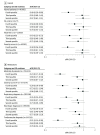Emergency Department Pediatric Readiness and Short-term and Long-term Mortality Among Children Receiving Emergency Care
- PMID: 36637819
- PMCID: PMC9857584
- DOI: 10.1001/jamanetworkopen.2022.50941
Emergency Department Pediatric Readiness and Short-term and Long-term Mortality Among Children Receiving Emergency Care
Erratum in
-
Error in Figure 1B.JAMA Netw Open. 2023 Feb 1;6(2):e231365. doi: 10.1001/jamanetworkopen.2023.1365. JAMA Netw Open. 2023. PMID: 36780168 Free PMC article. No abstract available.
Abstract
Importance: Emergency departments (EDs) with high pediatric readiness (coordination, personnel, quality improvement, safety, policies, and equipment) are associated with lower mortality among children with critical illness and those admitted to trauma centers, but the benefit among children with more diverse clinical conditions is unknown.
Objective: To evaluate the association between ED pediatric readiness, in-hospital mortality, and 1-year mortality among injured and medically ill children receiving emergency care in 11 states.
Design, setting, and participants: This is a retrospective cohort study of children receiving emergency care at 983 EDs in 11 states from January 1, 2012, through December 31, 2017, with follow-up for a subset of children through December 31, 2018. Participants included children younger than 18 years admitted, transferred to another hospital, or dying in the ED, stratified by injury vs medical conditions. Data analysis was performed from November 1, 2021, through June 30, 2022.
Exposure: ED pediatric readiness of the initial ED, measured through the weighted Pediatric Readiness Score (wPRS; range, 0-100) from the 2013 National Pediatric Readiness Project assessment.
Main outcomes and measures: The primary outcome was in-hospital mortality, with a secondary outcome of time to death to 1 year among children in 6 states.
Results: There were 796 937 children, including 90 963 (11.4%) in the injury cohort (mean [SD] age, 9.3 [5.8] years; median [IQR] age, 10 [4-15] years; 33 516 [36.8%] female; 1820 [2.0%] deaths) and 705 974 (88.6%) in the medical cohort (mean [SD] age, 5.8 [6.1] years; median [IQR] age, 3 [0-12] years; 329 829 [46.7%] female, 7688 [1.1%] deaths). Among the 983 EDs, the median (IQR) wPRS was 73 (59-87). Compared with EDs in the lowest quartile of ED readiness (quartile 1, wPRS of 0-58), initial care in a quartile 4 ED (wPRS of 88-100) was associated with 60% lower in-hospital mortality among injured children (adjusted odds ratio, 0.40; 95% CI, 0.26-0.60) and 76% lower mortality among medical children (adjusted odds ratio, 0.24; 95% CI, 0.17-0.34). Among 545 921 children followed to 1 year, the adjusted hazard ratio of death in quartile 4 EDs was 0.59 (95% CI, 0.42-0.84) for injured children and 0.34 (95% CI, 0.25-0.45) for medical children. If all EDs were in the highest quartile of pediatric readiness, an estimated 288 injury deaths (95% CI, 281-297 injury deaths) and 1154 medical deaths (95% CI, 1150-1159 medical deaths) may have been prevented.
Conclusions and relevance: These findings suggest that children with injuries and medical conditions treated in EDs with high pediatric readiness had lower mortality during hospitalization and to 1 year.
Conflict of interest statement
Figures


Comment in
-
Saving Children's Lives by Improving Pediatric Readiness for Emergency Care.JAMA Netw Open. 2023 Jan 3;6(1):e2250951. doi: 10.1001/jamanetworkopen.2022.50951. JAMA Netw Open. 2023. PMID: 36637827 No abstract available.
References
-
- McDermott KW, Stocks C, Freeman WJ. Overview of pediatric emergency department visits, 2015. Healthcare Cost and Utilization Project Statistical Brief 242. August 7, 2018. Accessed December 7, 2022. https://www.ncbi.nlm.nih.gov/books/NBK526418/ - PubMed
-
- National Center for Health Statistics . Emergency department visits within the pasts 12 months among children under age 18, by selected characteristics: United States, selected years 1997-208. 2019. Accessed December 7, 2022. https://www.cdc.gov/nchs/data/hus/2019/036-508.pdf
-
- Institute of Medicine, Committee on the Future of Emergency Care in the United States Health System . Emergency Care for Children: Growing Pains. National Academies Press; 2006. - PubMed
-
- Emergency Medical Services for Children (EMSC) National Resource Center . The National Pediatric Readiness Project. Accessed April 18, 2022. https://emscimprovement.center/domains/pediatric-readiness-project/

